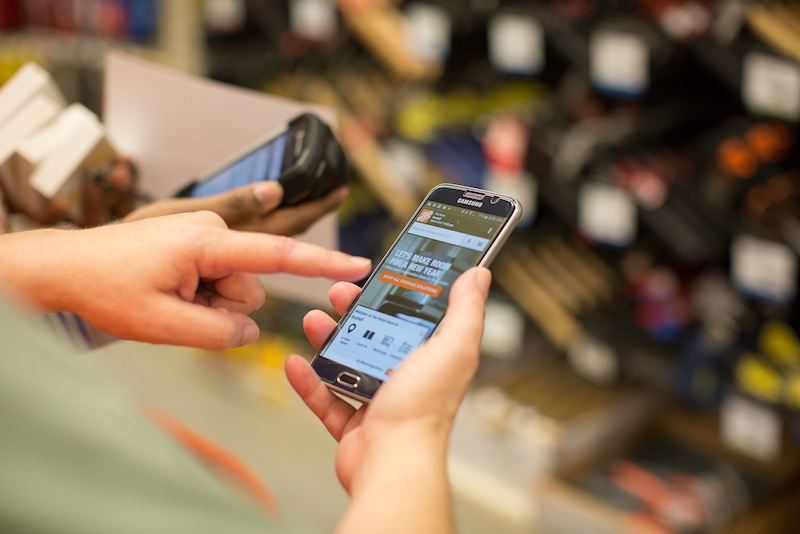In the last 10 years of marketing tech disruption and innovation, Home Depot has been a fascinating brand to watch. With 40 years of being a fixture for both seasoned professionals and families looking to sharpen their home improvement skills, it seems as if the brand has hardly changed. But behind the scenes, there’s a lot of work going on to deliver that familiar experience in a changing landscape.
I recently spoke with Matt Jones, senior director of digital strategy and mobile, Home Depot, to make sense of how the brick-and-mortar giant continues to stand the test of time. In short, he said the guiding strategy is to use tech solutions to enhance what customers already like about the brand, rather than using tech to try to transform it. Tech solutions on web and mobile have to emanate from the true source of Home Depot’s brand positivity: The everyday, in-store, customer-employee interactions. Home Depot dubbed the strategy “interconnected retail,” and so far, it’s proven fruitful.
Its Q2 earnings made headlines earlier this month, far surpassing what Wall Street was expecting: It reeled in earnings of $3.05 per share, $30.46 billion in revenue, and same-store sales rose 8 percent globally. That’s in defiance of a forecasted $2.84 per share, $30.03 billion in revenue, and 6.6 percent global increase.
Bernie Marcus and Arthur Blank — two handymen who’d recently been fired from a local hardware store in 1978 — dreamed up The Home Depot from a coffee shop in Los Angeles more than 40 years ago with the idea that customers of all skill levels could walk in and get the tools and insight they needed. The picture Jones painted of the current marketing tech strategy of “interconnected retail” sounds a lot like a continuation of what the brand’s founders had in mind.
“We’re trying to leverage the physical stores that we have — the store associates that we have, with some of the latest technology to really provide information to our customers where they want, when they want it when they need it,” Jones explained.
Interestingly, 47 percent of all online orders are picked up in stores. That tells Jones and the marketing team that there continues to be a real experiential quality for Home Depot’s shoppers that draws them physically into the buildings. It also reinforces the idea that certain brands should inform their tech solutions — not the other way around. The mobile tools available on the Home Depot app — voice search, chatbots, AR paint swatches and furniture shopping, store mapping and inventory information — make it so that customers can engage with the same store they like in new ways. So what kinds of tech get the green light and what kinds don’t?
With Home Depot’s mobile app specifically, Jones said, those decisions are largely steered by customer feedback. Providing detailed store mapping was a logical solution to having customers and contractors contending with the massive scale of the stores themselves — the average size of a Home Depot is 105,000 square feet, with an approximate inventory of 40,000 products. That’s a lot to navigate, regardless of your home repair expertise.
“It was easy to identify that there was a potential solution there,” Jones said. “It was easy to know that more and more customers were going to be walking into our stores with smartphones, and if we could provide aisle and bay-level information, and actually real-time inventory information before they’re even in the store, that that would be a huge help in cutting down on, you know, sort of time in the store or frustration or even lost trips to the store.”
It seems as though the mobile functionality on Home Depot’s app is divvied up to help people across the experience spectrum — from seasoned professionals to first-time home improvement shoppers. So, as valuable as a store map might inherently be, Jones said, inventory information via the store map might be much more valuable to a contractor. Contractors are always on the move and don’t always have the luxury of heading to their familiar or preferred store location. The app uses location data to help them find the nearest store with the inventory they need. The mission is the same here too: Enhance the already-robust Home Depot experience. Don’t make it more cumbersome.
Admittedly, Jones explained, there is a tremendous learning curve in figuring out what works and what doesn’t. There’s plenty of surprise and delight within the brand’s marketing team alone. Even for Home Depot, many of these mobile solutions are in what Jones called an “incubation stage.” He said that early trials and customer and data feedback can help brands chart a course for what comes next. For example, Home Depot’s in-app voice search is currently very product-centric. Jones said that the goal for that particular CX solution is to engineer it to be much more conversational and personable — in line with the experience customers can expect from their in-store associates, but available to them wherever they take their smartphone. That’s information only accessible after trial and error. It’s a repetitive cycle of returning to (and trying to answer) a central question — one that varies from brand to brand. “How do we use technology — how do we use the 400,000 associates that we have working for us in the stores — in the smartest, most optimal ways to really go above and beyond customer interaction we have?” Jones said.
That’s a big question, but the bar is set high for Home Depot — especially with stiff competition from Lowe’s and other major retailers who seem to be executing a similar brand-first, tech-second philosophy. The question of whether Home Depot can leverage its mobile and other omnichannel solutions to create a unique in-store experience remains to be seen. But if Jones’s update on the state of things is any indication, its team is asking the right questions.







